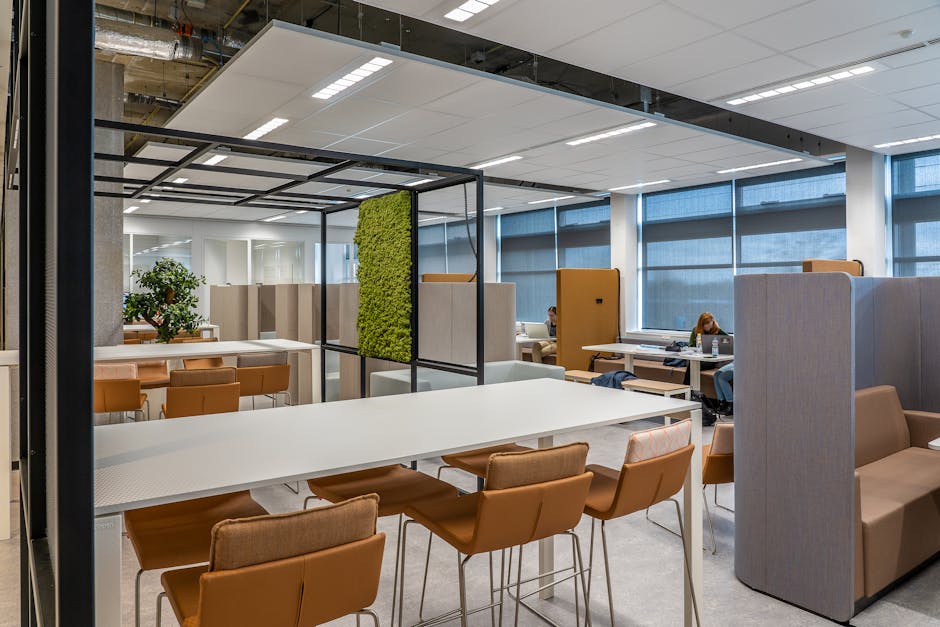The Ultimate Guide to Building an Agile Work Environment
“This ultimate guide explores how to build an agile workplace that's right for your organization and employees. Learn about the benefits, characteristics, and essential tools for creating a successful agile work environment that promotes productivity, collaboration, and flexibility. ”

What is an Agile Work Environment?
An agile work environment is a type of workspace that gives people flexibility in how they work. It encourages people to move about the office and make use of the variety of different spaces on offer. An agile working environment promotes collaboration and creativity by breaking down traditional office barriers.

For example, replacing permanently assigned desks with hot desks supports an agile working environment because it offers folks the option to choose where they sit. This helps to bring more coworkers closer and happier together when onsite.
An agile working environment should always be:
- Adaptable: Your agile working environment can accommodate different working styles. Think flexible furniture, technologies, and workplace policies.
- Accessible: Your agile working environment will enable employees to utilize spaces in your workplace without hassle. Tools and technologies work together seamlessly to enhance people's experience.
- Iterative: Your workplace improves as folks learn what spaces work best for them. Data plays a key role in understanding space utilization, so workplace teams need access to tools that provide real and historical space usage data.
Who Does an Agile Work Environment Work Best For?
Your agile work environment is a flexible work environment. When done right, it works best for everybody in the workplace. Full-time or part-time, hybrid, or 100% on-site–creating an agile work environment will enable everyone to use the workplace when and how they need it.
Your employees can leverage tools like office hoteling to choose where they sit in the office for set periods of time. They can also use meeting room tools to plan out their on-site days and maximize collaboration and productivity with others.
An agile work environment promotes team collaboration, too. Spaces are flexible and therefore have multiple uses. This means that if your team wants to get together, an agile working environment enables you to collaborate and brainstorm together in new and creative ways by choosing different areas.
Benefits of Building an Agile Work Environment
An agile work environment supports employee choice and flexibility. So it's no surprise that it comes with a lot of benefits for your organization. An agile work environment will help you:
1. Maximize Space Management
An agile work environment enables you to optimize your office layout to work better for you and your employees. This not only means finding use for empty or unused spaces in your workplace, but also thinking about how your physical space will need to change as different employees and teams use it.

2. Promote Productivity and Engagement
When folks can work in a way that suits them best, productivity and engagement will inevitably rise. An agile work environment offers people full autonomy over how they work. For some, this might be making use of quiet spaces where they put their head down and zone in. For others, it might be sitting close to coworkers to share ideas on the fly.
3. Save on Costs
Behind salaries, office rent is the highest expense for organizations. Coupled with flexible work policies, businesses are figuring out how to reduce overhead costs on unused and vacant space. This might be downsizing or reducing the number of floors. Or it could be looking at your existing workspace to see how better planning can result in cost-saving.
4. Encourage Collaboration Between Coworkers
In a traditional work environment, there are permanent desks and meeting rooms. This traditional structure allowed for easy separation of different needs. Nowadays, the modern office is more flexible. An agile work environment utilizes tools and space to rebuild parameters so work isn't restricted to a fixed location. Folks can move around easily, along with their ideas.
By building an agile workplace, you encourage folks to collaborate when and where they need to. This might be making use of breakout spaces to socialize and take some time away from the screen. It could also be a meeting room that coworkers have reserved to brainstorm ideas for an upcoming project.
4 Tools to Build a Healthy Agile Workspace
To make the most of your agile working environment, you need the right tools. Here are a few must-have tools that will help you build a healthy and successful agile workplace for everyone to enjoy.
1. Hot-Desking
Hot desking is a flexible seating arrangement where folks can reserve a desk for the day. This offers employees maximum flexibility when they visit the office. Because hot desking is often short-term and on-demand, folks can get the maximum level of flexibility when they work from the office.
2. Agile Room Booking
Agile room booking streamlines the room reservation process by utilizing the power of technology. It offers employees flexibility in finding the right meeting space for their needs so they can do their best work while on-site.
Room booking technology allows you to book a room in advance, on the fly, on a mobile app, or as a dropdown in your calendar. That means that when folks need a meeting room, they can easily find and book available spaces from their laptop or mobile devices.

3. Office Hoteling
Office hoteling is a flexible way of reserving a desk or room in your workplace for a set period of time. As the name suggests, hoteling operates in the same way as an actual hotel. You make a reservation, you check-in, you complete your stay, you check-out.
Very similar to hot-desking, office hoteling supports an agile work environment by giving employees the option to book desks whenever they need to. Unlike hot-desking, office hoteling allows employees more flexibility in location, length or stay, and the size of a desk or room.
4. Workspace Analytics
Last but not least, you'll need a way to track how your agile workplace is actually being used in order to iterate and improve. Workspace analytics is important as people return to work. It will give you visibility into what spaces your employees are using most and how they're using them.
As the data comes in, you can then iterate and optimize your agile work environment. For example, if you're finding that meeting rooms are fully booked a lot of the time, then you might want to encourage employees to make use of breakout areas for 1:1 discussions or more informal meetings.

Conclusion
There's a lot to love about working in an agile workplace. When used correctly, it offers employees maximum flexibility and allows them to work in a way that works for them. This is an ultimate win for organizations. Happier employees bring about a whole host of benefits: improved productivity, better results, and longer retention to name a few.
Building an agile workplace takes work and investment in the right tools. By creating an adaptable, accessible, and iterative environment, you can foster a positive workplace culture that supports the diverse needs of your employees.